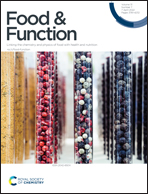Ginsenoside Rk1 regulates glutamine metabolism in hepatocellular carcinoma through inhibition of the ERK/c-Myc pathway†
Abstract
Hepatocellular carcinoma (HCC) is one of the most prevalent and deadly cancers in the world. Recently, suppression of glutamine metabolism has become one of the hottest therapy targets for cancer treatment. There is a growing amount of research that indicates that ginsenosides possess good anti-tumor activity. However, the effect of ginsenoside Rk1 on glutamine metabolism in HCC is unclear. In this study, Rk1 was demonstrated to be effective at inhibiting the proliferation of HCC through the induction of cell cycle arrest and apoptosis. Especially, Rk1 was shown for the first time to inhibit glutamine metabolism in HCC. Rk1 downregulates GLS1 expression, and consequently decreases the GSH production, stimulating ROS accumulation to induce apoptosis. In addition, transcriptomic results showed that the ERK/c-Myc signaling pathway was enriched in HepG2. Rk1 exerts an inhibitory effect on glutamine metabolism in HCC by regulating the ERK/c-Myc signaling pathway, and inducing apoptosis in vitro and in vivo with less toxicity. Therefore, ginsenoside Rk1 could be a promising candidate for the clinical treatment of HCC.

- This article is part of the themed collection: Food & Function HOT Articles 2022


 Please wait while we load your content...
Please wait while we load your content...